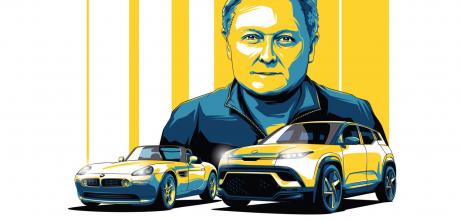The DrivesToday Inquisition: Great lost EV pioneer Henrik Fisker
‘Kale without dressing? No thanks’ After ups and downs, Fisker now has a breakthrough car – what took boss Henrik so long?
HENRIK FISKER FISKER CEO
Henrik Fisker was the talent behind some of the best-looking cars from the turn of the century. He designed the late-’90s BMW Z8 (and helped shape the first-gen X5) before overseeing the DB9 and V8 Vantage as Aston Martin design director in the early ’00s. But his business record since, under various Fisker-branded ventures, has been patchy, to put it politely.
The Fisker Ocean full-electric SUV – self-billed as ‘the world’s most sustainable vehicle’ on account of its recycled elements, onboard solar power and carbon-neutral factories – could yet change that. It’s set to launch later this year, but first we need a quick recap. His first own-brand Fisker Coachbuild venture in 2005 resulted in a re-worked Mercedes SL – the Tramonto – and the BMW 6-series-based Latigo CS. Both sold like cold cakes. ‘Looking back, they weren’t me,’ he reflects. ‘I tried to please somebody else too much.’ In 2007 he was hired by Tesla to do initial design work on the Model S and, in that same year, set up Fisker Automotive. The 2011 electric Karma saloon (with range-extender petrol unit) was the firm’s only production model, despite major financial backing from the US government and film star Leonardo DiCaprio.
Fisker resigned in 2013 and the company went bankrupt (later reborn as Chinese-backed Karma Automotive). Then, in 2016, Fisker Inc was formed and its first Ocean production car unveiled at the AutoMobility LA show, where CAR caught up with the man himself.
Straight in with the big question: why should anyone believe in his latest venture? ‘It was the Wild West back in 2007 and nobody wanted to work with us,’ he concedes. ‘There were only three battery companies – Panasonic made a deal with Tesla, LG Chem had an exclusive with GM, and A123, a Boston startup we had no choice but to use, went bust.
‘Now we have a more mature supply chain around electric components and new financial backers. When Fisker started, they were all Silicon Valley types, drip-feeding money. That stop-and-start mentality was terrible for developing new technology. Today, Wall Street is 100 per cent convinced the majority of the market in the future could be EV start-ups. I think they’re right.’
Fisker also has the backing of Austrian manufacturer Magna Steyr. It contract-builds the Jaguar i-Pace, Mercedes G-Class and Toyota Supra, and will make the Fisker Ocean too. Experience centres are planned and servicing will be done by third parties booked via an app. ‘That takes out a lot of risk, so we can focus on developing the vehicle,’ says the 58-year-old Danish-American.
How is the 4775mm-long Ocean – a little longer than a Tesla Model Y – going to stand out in the already busy mid-size electric SUV segment, though? One USP is its rotating centre screen, which can switch from portrait to landscape. ‘It’s 17.1 inches, so it’s like having your own movie theatre inside the car,’ he enthuses. Fisker is also aiming for a long range (390 miles), a quick 0-62mph time of 3.6 seconds and a solar-panelled roof which, under Californian skies, could harvest 2000 miles a year.
The Ocean is also on its way to the cloudier climes of the UK, priced from £34,990 for the single-motor FWD Sport, rising to £59,900 for the top-spec dual-motor AWD. Up close it looks pretty good too, with a wide (1995mm) stance, super-slim lights and neat graphic details. Fisker wants to shift 35,000-40,000 Oceans in the first year, quickly rising to 100,000 a year, followed by an urban vehicle named Project PEAR (for Personal Electric Automotive Revolution). Two more models are slated by 2025. ‘One will be an enthusiast sporty vehicle [north of $100k and developed in the UK] and another, likely on the Ocean platform,’ he adds.
Again, big claims, and we’d be inclined to take them with a big pinch of salt were it not for the combination of new funding, Magna’s manufacturing pedigree and the smart design and tech of the car itself.
‘I would like to get to a million units a year, and go further,’ Fisker says. ‘By 2027 we want to make the first CO2-neutral vehicle. That’s difficult but we’ve had supplier buy-in.
Sustainability only works if you have desirable vehicles. No one wants a kale salad without dressing. We started with all these weird little EVs but now there are some great ones, and the new milestones are happening in the start-up area. Traditional car makers are making EVs, but they’re not beating anyone.’
Six questions only we would ask
Tell us about your first car…
‘A rust-brown, gold-striped Alfasud. The engine blew up after a few weeks’ racing as there was no rev limiter.’
What achievement makes you most proud?
‘The Ocean and the work put into its sustainability.’
What’s the best thing you’ve ever done in a car?
‘After joining Aston, I drove a V12 the wrong way to my first CEO appointment. After realising, I hit 175mph on the M40. Got caught, went to court. Getting out is another story...’ Tell us about a time you screwed up…
‘Many times. At Fisker Coachbuild I made subdued designs. They flopped because I didn’t trust my gut.’
Supercar or classic?
‘Classic. The supercar segment is so saturated and irrelevant at speeds you can’t use. You can’t have fun.’
Curveball… Which James Bond film was the Z8 in?
‘The World Is Not Enough in the year 2000, or maybe 1999 [1999 is correct]. It wasn’t ready so we built fakes!’


